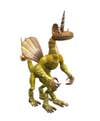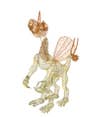We may earn revenue from the products available on this page and participate in affiliate programs. Learn more ›
Electronic Arts/Maxis Spore Image 1
In the computer game Spore—developed by Will Wright, of The Sims fame—you can create your own characters in various stages of life.
Electronic Arts/Maxis Spore Image 2
Most of the creatures you see in the game come from other players. Spore uploads their designs to an online database, and then your game chooses from these options every time you encounter another creature or vehicle. You can also download individual characters yourself. To make this transfer speedy, programmers boiled all the info needed to recreate a character—such as size and personality type—into a short text code, like virtual DNA. Then they included this text in the metadata of a small graphics file, like the one shown here, so you can import an entire creature, mannerisms and all, just by downloading a small picture.
Electronic Arts/Maxis Spore Image 3
This is an image of Spore’s behind-the-scenes animation system. It shows the boxes that represent the bones in the skeleton of the character Xiphor.
Electronic Arts/Maxis Spore Image 4
Many animation systems represent objects as a collection of triangles. This behind-the-scenes image shows the triangles that make up the character Xiphor.
Electronic Arts/Maxis Spore Image 5
This is a behind-the-scenes image of how a character’s skin is smoothly applied.
Electronic Arts/Maxis Spore Image 6
If you like characters designed by a certain player, or with a certain appearance, you can subscribe to an RSS feed called a “Sporecast” that automatically downloads these creations for you.
Electronic Arts/Maxis Spore Image 7
To let amateurs design characters—a job usually done by pro animators—engineers came up with a simple drag-and-drop interface. You just pick body parts and then bend and stretch them into different shapes.
Electronic Arts/Maxis Spore Image 8
When you select a color or pattern, Spore figures out how to bend it realistically over a creature’s shape.








